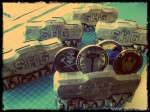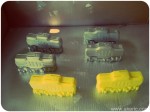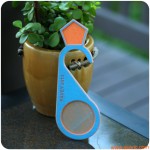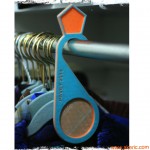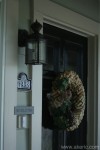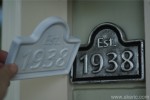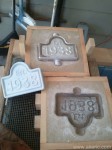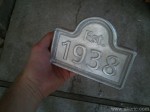I picked up some small but powerful cylindrical magnets, 8mm diameter by 3mm tall, to incorporate into a new multi-part 3d print: They’ll help hold the whole thing together. I print mainly in PLA, and while it shrinks less than ABS, it still shrinks, so I needed to make sure that the cylindrical holes I design in my 3d model will actually allow the magnets to fit, based on how my Makerbot Replicator (1) prints things.
Using my micrometer, I checked the size of the magnets: They were within a few hundredths of a mm of their spec: Negligible change.
I designed & printed a simple rectangular volume to place my test holes: It measured 60x30x3 mm. In it I placed three different holes with diameters of 7.5, 8.0, and 8.5 mm. For the record its print specs are: 300 micron layer resolution, 2 shells, 10% infill, blue PLA extruded @ 220 deg, HBP off, on blue painters tape. My print nozzle is .4mm. Took about 12 minutes, and was firmly affixed to the build platform before removal with no curling.
You can see the results below:

So what were the results? Checking with my micrometer….
- The outer dimensions of the printed rectangular volume were very close to the 3d model: .1 mm larger (or less) on X, Y, & Z.
- The printed cylindrical holes were each nearly exactly .5mm smaller from the 3d model: As you can see from the above image, the modeled 7.5mm hole ended up being printed @ 7.0 mm, the 8.0 hole @ 7.5mm, and the 8.5mm hole @ 8.0 mm.
- Because of this, the 8mm wide magnet fits snugly into the 8.5mm modeled hole, which ended up printing with a 8.0mm diameter.
- Another interesting side effect: Even though the rectangular volume and magnet were both 3mm high, and the magnet fit in the whole snugly but easily, I was unable to push it all the way through without some force: I believe this is because the first few layers probably ‘squish out’ more on the build platform, causing a slight lip to form on the bottom edge. Nothing a drill or file (or obsessive-compulsive magnet pushing) couldn’t fix though.
So this raises the question: Why does the outer-volume of the rectangle match the 3d model within .1 mm larger, but the interior cylinders are all .5 mm smaller?
